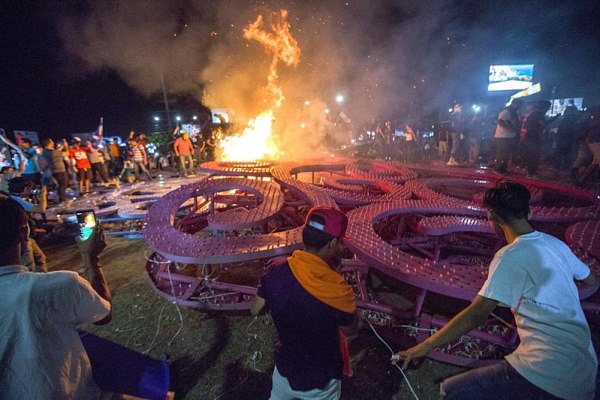By Kenneth M. Coleman*

On Saturday, April 21, 2018, Nicaraguan protesters burned an “Árbol de la Vida” (Tree of Life), one of several monumental statues that are considered representations of President Daniel Ortega’s government. / Jan Martínez Ahrens / Wikimedia / Creative Commons
The street protests that wracked Nicaragua last week may or may not recede after President Daniel Ortega backed off a controversial increase in social security taxes, but the damage to his image of invincibility will linger and could turn out to be a watershed in his and his wife’s grand plan for one-party rule. Ortega mobilized the police, which have teamed up with young thugs over the years to intimidate those who protest government policies, to repress what started last week as peaceful protests against the increased taxes but evolved into a challenge of the authoritarian nature of the regime. The government closed four television stations that were covering the street protests; shock troops from his party’s Juventud Sandinista burned down a radio station in León; and journalists faced harassment, one having been killed. Local press estimates 20-30 deaths, with surely well over a hundred injured.
The street protesters were not alone in their struggle. The Superior Council of Private Enterprise (COSEP) and American Chamber of Commerce in Nicaragua (AMCHAM) – which for years had become silent accomplices in the efforts of Ortega and his wife, Rosario Murillo, to consolidate their power – called for solidarity with the popular protests. For the first time in the current Ortega era (2007-2018), they openly called for street marches to resume today. More importantly, they used hard language – condemning the use of fuerzas de choque by the government – and issued a set of conditions before a “dialogue” with the government can begin. Specifically, they demanded that students, university communities, and the Bishops Conference of the Catholic Church be included in any dialogue, surrendering their previous role as privileged interlocutor with the government. (The Catholic Church provided respite and support – both moral and physical – to student protesters.)
Mass movements can start from little sparks and grow into society-wide convulsions. The outcome of these new confrontations with the Ortega-Murillo government cannot be foreseen at this point, but the parallels with other governments on their last legs are striking. The use of excessive force by Mexican police in 1968 triggered massive street protests that directly questioned the legitimacy of a seemingly well-established Mexican one-party state – legitimacy that was ultimately resurrected only by opening the system to genuinely democratic competition. While the process took two decades, it did lead to an opposition victory in the 1990 presidential election. In Nicaragua, the fall of Anastasio Somoza in 1979 accelerated when the business community eventually abandoned his dictatorship.
- Ortega’s party, the Frente Sandinista de Liberación Nacional (FSLN), for many years has been able to isolate, contain, and discredit those abandoning it, including a former Sandinista Vice President and former members of its National Directorate. Grumbling within the party is already growing louder because of a succession plan bringing Rosario Murillo to power upon the illness or death of Ortega in a manner that far exceeds her status as vice president. Local press reports indicate that one police commander and her unit of 50 officers have been jailed due to their unwillingness to confront and repress protesters in the streets. The excessive application of force against peaceful protesters last week and, potentially, in coming days might lead to a more serious rupture, making last week’s events a potential inflection point for Nicaragua – with potentially dire consequences for Ortega and Murillo’s political ambitions.
April 23, 2018
* Kenneth M. Coleman is a political scientist at the Association of American Universities who directed the 2014 AmericasBarometer national survey in Nicaragua.
